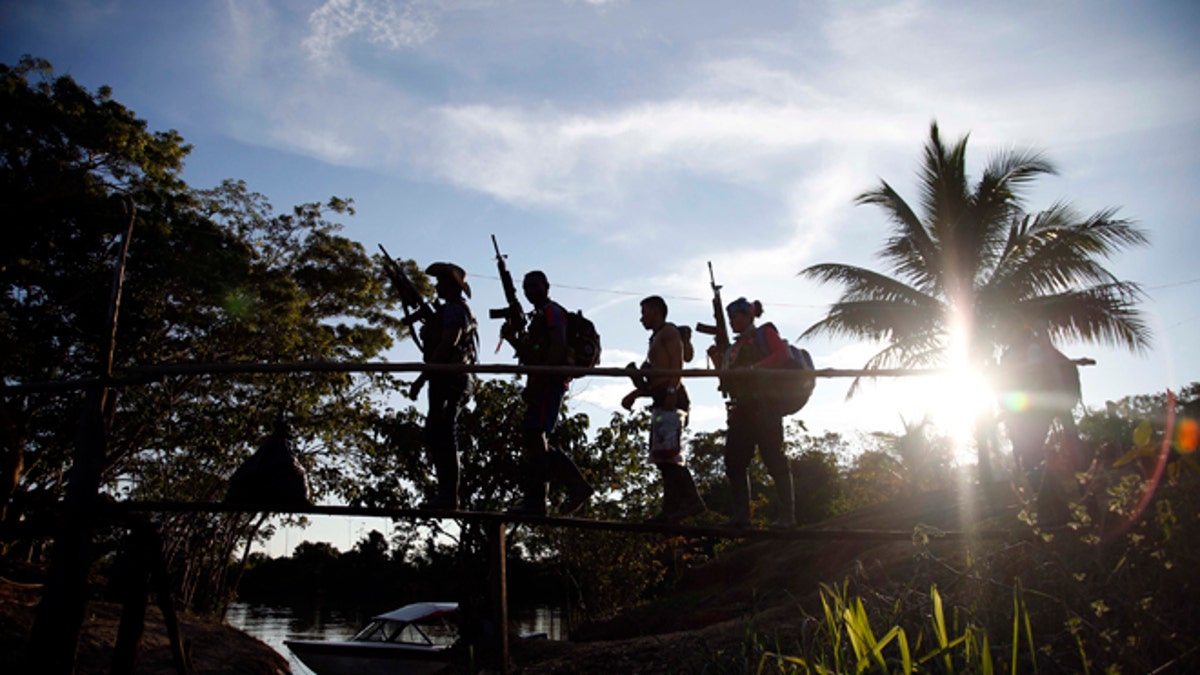
In this Aug. 12, 2016 photo, rebels of the 48th Front of the Revolutionary Armed Forces of Colombia walk on a makeshift footbridge in the southern jungles of Putumayo, Colombia. (AP Photo/Fernando Vergara)
As President Juan Manuel Santos declared that a ceasefire will start next week in the wake of a peace deal signed on Wednesday between the government and the Revolutionary Armed Forces of Colombia (FARC) guerrilla group, Colombians – both at home and in the U.S. – are deeply divided over the historic agreement that aims to end the longest-running civil conflict in Latin America.
Following more 50 years of warfare that left more than 218,000 people dead and between 4.7 and 5.7 million people displaced from their homes, some Colombians – Santos first and foremost – see the peace deal as the only viable way to stop the bloodshed between the military and the FARC.
"Today is the beginning of the end to the suffering, pain and tragedy of war," Santos said in a televised address on Wednesday. “Let’s open the door together to a new stage in our history.”
Others, however, say that after four years of on-and-off negotiations between the two sides the FARC – and all of its brutality – comes out the winner in the deal, with light punishments for its top lieutenants and a guaranteed five seats in both the country’s House and Senate.
The accord also requires Colombia to carry out aggressive land reforms, overhauling its anti-narcotics strategy and greatly expanding the state's presence in long-neglected areas.
“The peace process gives the FARC a lot of political power,” Fabio Andrade, a Colombian living in South Florida and founder of the Americas Community Center, told Fox News Latino. “Santos is giving the FARC so much. He’s basically the leader of the FARC now.”
“And what about the rebels who don’t want to demobilize. They will just return to drug trafficking.”
There are many people in Colombia who think like Andrade when it comes to the FARC.
Polls say most Colombians loathe the rebel group and show no hesitation labeling them "narco-terrorists" for their heavy involvement in Colombia's cocaine trade, an association for which members of the group's top leadership have been indicted in the U.S.
The most contentious breakthrough came last September when Santos traveled to Havana to lay out with FARC commander Rodrigo Londoño a framework for investigating atrocities, punishing guerrillas for involvement in those abuses and offering compensation to victims.
Opponents of Santos and some human rights groups harshly criticized a key part of that deal that would let rebels who confess their crimes avoid jail and instead serve reduced sentences of no more than eight years by helping rebuild communities hit by the conflict.
Some observers contest the sentiment that the FARC will be allowed to walk away without any form of punishment for their crimes.
“In the view of many, the agreement goes way beyond anything any other country in similar situations around the world has done,” Adriana La Rotta, a columnist with Colombia's El Tiempo newspaper and the media relations director for the Americas Society/Council of the Americas, told FNL. “There is no blanket amnesty. It is quite the opposite of that.”
Analysts of the peace deal say that the support for the agreement is very much divided between the rural and urban populations of the country. The violence between the military and FARC has remained exclusively in rural areas – directly impacting those who live in remote parts of the country.
While the FARC had previously relied on kidnapping and extortion from wealthy families in cities like Bogotá and Medellin to fund their campaigns, in recent years they have shied away from these tactics in favor of the more lucrative profits to be made in Colombia’s infamous drug trade.
“For the most part the average Colombian today is urban and the war is just something they saw on TV,” Adam Isacson, a senior associate at the Washington Office on Latin America told FNL. “These people haven’t really been affected by the war since the mass kidnappings.”
La Rotta echoed these remarks saying that the vast majority of Colombians now live in urban areas and because they don’t see the violence daily don’t see the point in stopping a war that Colombian forces are seemingly winning.
The beginning of the peace talks began as the FARC were forced to the negotiating table in 2012 after a decade of heavy battlefield losses inflicted by a military offensive that was engineered in large part by Santos when he was former President Alvaro Uribe’s defense minister. Several top rebel commanders were killed and its ranks thinned by half to the current 7,000 guerrillas.
But military strategists, La Rotta said, conferred that despite the FARC’s depleted numbers, historical precedence in other parts of the world and the guerrilla group’s ability to rebound made wholly defeating the entrenched rebels nearly impossible.
“People who don’t live through the war, who live in big cities or don’t live in Colombia, they don’t think this deal is necessary,” she said. “They are not living the war everyday like those in the rural regions.”
Before the peace deal can move forward, Colombians must vote in favor of it during a vote in October. Polling data on support for the deal widely varies and the opposition also is likely to try to convert the vote into a referendum on Santos, whose approval rating is near the lowest it has been since he took office in 2010.
Possible low voter turnout is also a concern because a minimum of 13 percent of the registered voters, or about 4.4 million people, must vote in favor for the accord to be ratified.
